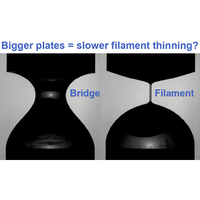谨防 CaBER:纤维稀化流变仪并不总能给出聚合物溶液的 "松弛 "时间
IF 2.5
3区 物理与天体物理
Q2 PHYSICS, FLUIDS & PLASMAS
引用次数: 0
摘要
聚合物溶液的粘弹性弛豫时间通常采用毛细管破裂延伸流变仪(CaBER)进行测量,将液滴置于两块板之间,然后将两块板拉开以形成细丝。对于低粘度液体,为了避免惯性毛细管振荡,需要采用缓慢的平板回缩协议。我们的实验表明,从指数稀化机制推断出的 CaBER 松弛时间 τe 实际上是表观松弛时间,当平板直径和液滴体积增大时,表观松弛时间可能会显著增加。同样,我们观察到,在商用(Haake)CaBER 设备的经典阶跃应变板分离协议中,τe 随板直径的增大而增大,而在基底上滴注(DoS)方法中,τe 随喷嘴直径的增大而增大。这种对粘弹性细丝形成前流动历史的依赖性与奥尔德罗伊德-B 等聚合物模型相矛盾,这些模型预测细丝变细率为 1/3τ(τ 为模型的松弛时间),这是一种与几何因素无关的材料特性。我们的研究表明,这不是由于溶剂蒸发或聚合物降解等人为因素造成的,只有在粘性溶剂中的稀聚合物溶液,而不是在低粘度溶剂中的半稀释溶液中,才能通过有限延伸性效应(FENE-P 模型)合理解释这一现象。本文章由计算机程序翻译,如有差异,请以英文原文为准。

Beware of CaBER: Filament thinning rheometry does not always give ‘the’ relaxation time of polymer solutions
The viscoelastic relaxation time of a polymer solution is often measured using capillary breakup extensional rheometry (CaBER) where a droplet is placed between two plates which are pulled apart to form a thinning filament. For a slow plate retraction protocol, required to avoid inertio-capillary oscillations for low-viscosity liquids, we show experimentally that the CaBER relaxation time inferred from the exponential thinning regime is in fact an apparent relaxation time that may increase significantly when increasing the plate diameter and the droplet volume. Similarly, we observe that increases with the plate diameter for the classical step-strain plate separation protocol of a commercial (Haake) CaBER device and increases with the nozzle diameter for a dripping-onto-substrate (DoS) method. This dependence on the flow history before the formation of the viscoelastic filament contradicts polymer models such as Oldroyd-B that predict a filament thinning rate ( being the model's relaxation time), which is a material property independent of geometrical factors. We show that this is not due to artifacts such as solvent evaporation or polymer degradation and that it can be rationalized by finite extensibility effects (FENE-P model) only for a dilute polymer solution in a viscous solvent, but not for semidilute solutions in a low-viscosity solvent.
求助全文
通过发布文献求助,成功后即可免费获取论文全文。
去求助
来源期刊

Physical Review Fluids
Chemical Engineering-Fluid Flow and Transfer Processes
CiteScore
5.10
自引率
11.10%
发文量
488
期刊介绍:
Physical Review Fluids is APS’s newest online-only journal dedicated to publishing innovative research that will significantly advance the fundamental understanding of fluid dynamics. Physical Review Fluids expands the scope of the APS journals to include additional areas of fluid dynamics research, complements the existing Physical Review collection, and maintains the same quality and reputation that authors and subscribers expect from APS. The journal is published with the endorsement of the APS Division of Fluid Dynamics.
 求助内容:
求助内容: 应助结果提醒方式:
应助结果提醒方式:


